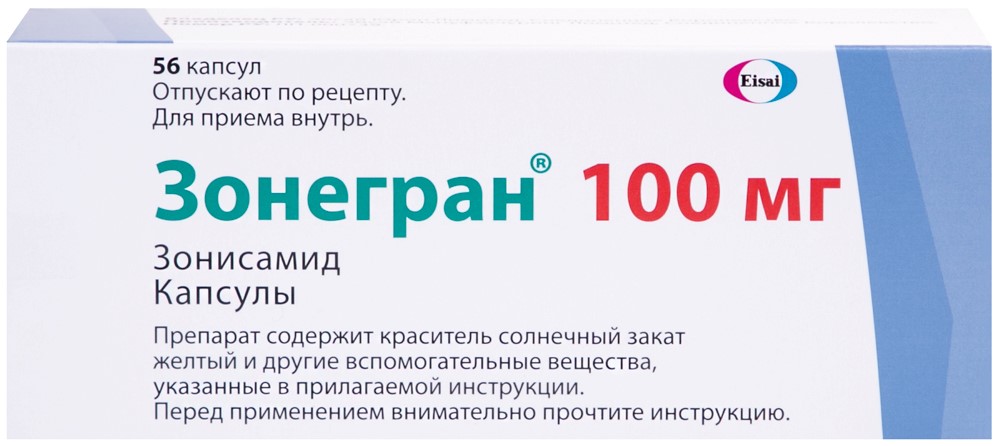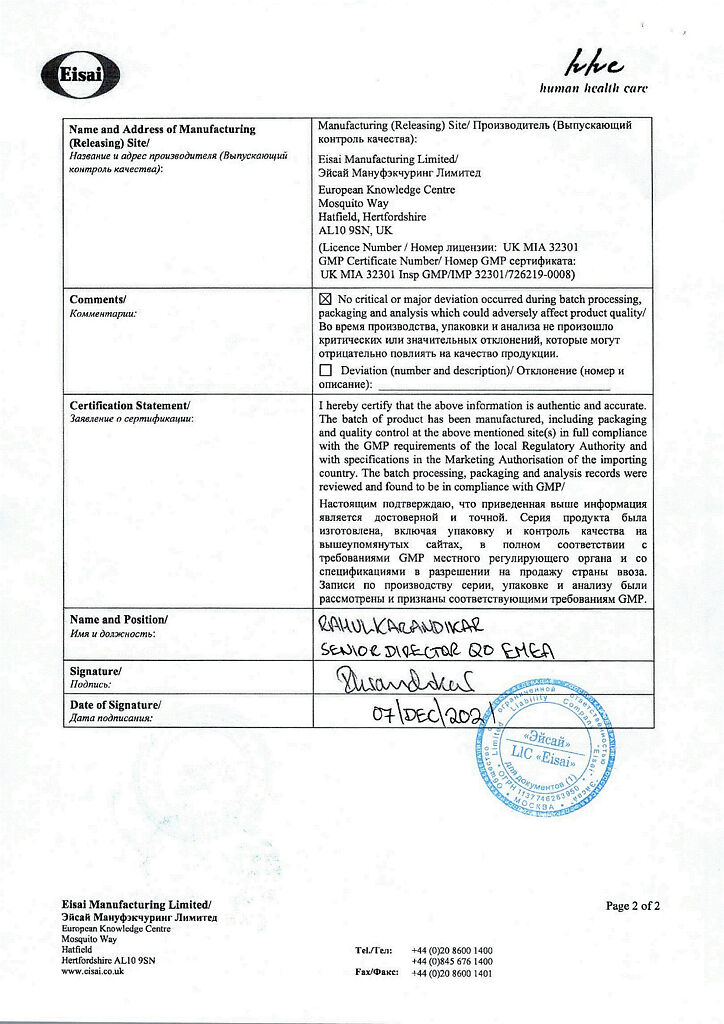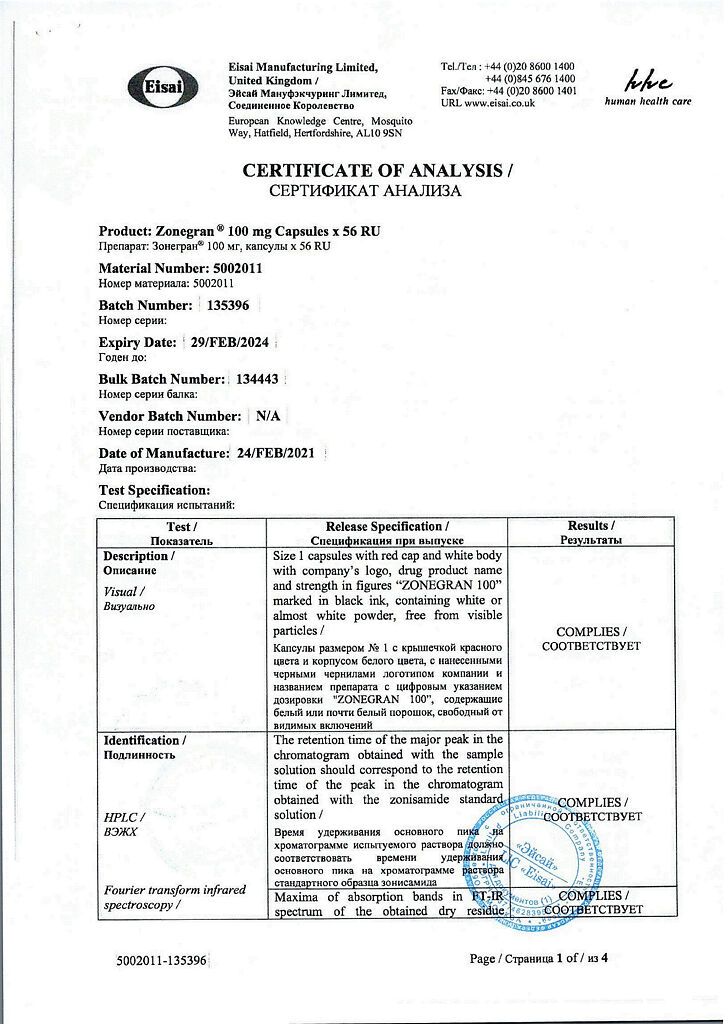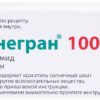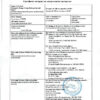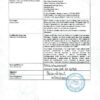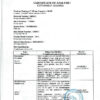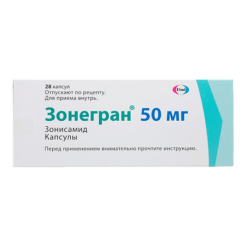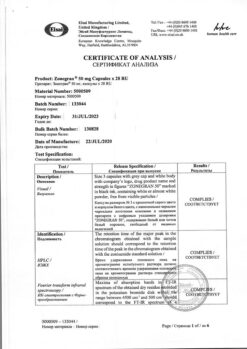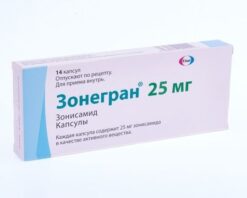No products in the cart.
Zonegran, 100 mg capsules 56 pcs
€158.15 €137.07
Description
Zonegran is an antiepileptic.
Pharmacodynamics
Zonisamide is an antiepileptic agent, a benzisoxazole derivative, in vivo weakly inhibits carboangidase. Chemically, its structure is different from other antiepileptic drugs.
The mechanism of action
The mechanism of action of zonisamide is not fully understood; it probably blocks potential-sensitive sodium and calcium channels, reduces the severity of synchronized neuronal excitation, inhibits seizure development and prevents further spread of epileptic activity. Zonisamide also reduces seizure activity of neurons by enhancing the inhibitory effect of GABA.
Pharmacodynamic Effects
The anticonvulsant activity of zonisamide has been studied in various epilepsy models, in groups with induced or congenital seizures, with zonisamide showing itself to be an antiepileptic agent of broad spectrum action. Zonisamide prevents the development of maximal electroconvulsive seizures, limits the development of seizures, including the spread of the focus of excitation from the cortex to subcortical structures, and suppresses epileptogenic focus activity. Unlike phenytoin and carbamazepine, zonisamide has a selective effect on seizures occurring in the cortex.
Clinical efficacy
Monotherapy of partial seizures with or without secondary generalization.The efficacy of zonisamide in monotherapy in patients with newly diagnosed partial seizures with or without secondary generalization, with generalized tonic-clonic seizures without clear foci, has been demonstrated in a double-blind, parallel-group, 583 adult patient study to establish the equal effectiveness of Zonegran® therapy over sustained-release carbamazepine therapy, which lasted up to 24 months depending on treatment response. The dose was increased up to the target value of 600 mg of carbamazepine or 300 mg of zonisamide. If patients had seizures, the dose was increased to the next dose, i.e., 800 mg of carbamazepine or 400 mg of zonisamide. If seizures persisted, the dose was increased to a maximum of 1200 mg for carbamazepine and 500 mg for zonisamide. Patients who had no seizures at 26 weeks on the target dose continued on the same dose for an additional 26 weeks.
Additional therapy for partial seizures with or without secondary generalization in adults. The efficacy of adjunctive therapy with zonisamide has been shown in 4 double-blind, placebo-controlled studies lasting up to 24 weeks. These studies showed a reduction in the median incidence of partial epileptic seizures when zonisamide was given in daily doses of 300-500 mg once or twice daily.
Additional therapy for partial seizures with or without secondary generalization in adolescents and children from 6 years of age. In children (ages 6 years and older), the efficacy of zonisamide was demonstrated in a double-blind, placebo-controlled, 24-week study involving 207 patients. At the 12-week target dose, there was a 50% or greater reduction in seizure frequency in 50% of patients who received zonisamide and 31% of patients who received placebo.
Particular safety concerns that have arisen in studies in children have included: worsened appetite and weight loss, decreased bicarbonate levels, increased risk of urolithiasis, and dehydration. All of these phenomena and especially weight loss can adversely affect child growth and development and can also lead to poorer overall health. In general, there is limited data on the long-term effects of the drug on child growth and development.
Pharmacokinetics
Intake
Zonisamide is almost completely absorbed after oral administration, Cmax in plasma is reached within 2-5 h after administration. The expression of primary metabolism is insignificant – the absolute bioavailability is estimated at 100%. Bioavailability of zonisamide when administered orally is not dependent on food intake, although the time to reach Cmax in plasma may be delayed.
The AUC and Cmax values of zonisamide increase almost linearly after a single dose (in the dosage range 100-800 mg) and after multiple doses (in the dosage range 100-400 mg once daily). The increase in these values when reaching the equilibrium state was slightly greater than expected based on the dose taken, possibly due to the saturation of zonisamide binding to erythrocytes. The equilibrium state is reached within 13 days. There is slightly more accumulation than expected when compared to a single dose.
Distribution
Zonisamide binds to plasma proteins by 40-50%; according to the results of in vitro studies, different anticonvulsants (phenytoin, phenobarbital, carbamazepine and sodium valproate) do not affect significantly the degree of its binding to plasma proteins. The apparent Vd in adults is 1.1-1.7 L/kg, indicating a significant distribution of zonisamide in tissues. The ratio of zonisamide concentrations in erythrocytes to plasma is about 15 at low concentrations and about 3 at high concentrations.
Metabolism
Zonisamide is metabolized with participation of CYP3A4 isoenzyme; the main metabolic pathway is cleavage of the benzisoxazole ring to form 2-sulfamoylacetylphenol (SMAP), and N-acetylation.
The starting substance and SMAP can bind to glucuronic acid. Metabolites that are not detected in plasma lack anticonvulsant activity. There is no evidence that zonisamide can induce its own metabolism.
The clearance of zonisamide after reaching Css reaches 0.70 l/h, the final T1/2 is about 60 h (assuming no simultaneous administration of inducers of CYP3A4 isoenzyme activity). T1/2 does not depend on the dose taken or the duration of treatment. Fluctuations in plasma concentration of zonisamide are insignificant (< 30%). Metabolites and unchanged zonisamide are excreted mainly through the kidneys. Renal clearance of unchanged zonisamide is relatively low (about 3.5 ml/min); about 15-30% of the dose taken is excreted unchanged.
Linearity/nonlinearity
The concentration of zonisamide increases until an equilibrium state is reached, which usually occurs after approximately 8 weeks. When comparing the same dose level, patients with higher body weight tend to achieve lower serum Css, but these differences are not significant. Age (≥12 years) and sex, adjusted for body weight, have no effect on zonisamide concentrations in patients with epilepsy when the Css of the drug is reached. There is no need for dose reduction with any antiepileptic drugs (PEDs), including CYP3A4 isoenzyme inducers.
Ratio of pharmacodynamics and pharmacokinetics
Zonisamide decreases mean seizure frequency over a 28-day period, and this decrease is proportional (log-linear relationship) to mean zonisamide concentration.
Performance in special patient groups
Patients with renal impairment. In patients with renal impairment, the renal clearance of single doses of zonisamide is directly proportional to Cl creatinine. The AUC of zonisamide is increased by 35% in patients with severe renal impairment (Cl creatinine < 20 ml/min) (see “Dosage and administration”).
Patients with hepatic impairment. The pharmacokinetics of zonisamide in patients with hepatic impairment have not been adequately studied.
Patients in the elderly. There are no clinically significant differences in the pharmacokinetics of zonisamide in young (21-40 years) and elderly (65-75 years) patients.
Patients of pediatric age (5-18 years). Limited data show that the pharmacokinetic parameters of zonisamide at a daily dose of 1, 7, or 12 mg/kg in children and adolescents are similar to those in adult patients (adjusted for body weight).
Indications
Indications
Zonegran® is indicated:
• in monotherapy in adult patients with partial epileptic seizures with or without secondary generalization, with newly diagnosed epilepsy.
• as part of additional therapy in adults, adolescents and children over 6 years of age with partial epileptic seizures with or without secondary generalization.
Pharmacological effect
Pharmacological effect
Pharmacotherapeutic group: antiepileptic drug, other antiepileptic drugs.
ATX code: N03АХ15
Pharmacodynamics
Zonisamide is a benzisoxazole-derived antiepileptic drug that weakly inhibits carbonic anhydrase in vitro. Chemically, its structure differs from other antiepileptic drugs.
Mechanism of action
The mechanism of action of zonisamide is not fully understood; it probably blocks voltage-sensitive sodium and calcium channels, reduces the severity of synchronized neuronal excitation, inhibits the development of seizures and prevents further spread of epileptic activity. Zonisamide also reduces neuronal seizure activity by enhancing the inhibitory effect of gamma-aminobutyric acid (GABA).
Pharmacodynamic effects
The anticonvulsant activity of zonisamide has been studied in various models of epilepsy, in groups with induced or congenital seizures, and zonisamide has been shown to be a broad-spectrum antiepileptic drug. Zonisamide prevents the development of maximum electroconvulsive seizures, limits the development of seizures, including the spread of the focus of excitation from the cerebral cortex to the subcortical structures, and also suppresses the activity of the epileptogenic focus. Unlike phenytoin and carbamazepine, zonisamide has a selective effect on seizures originating in the cerebral cortex.
Clinical efficacy and safety
Monotherapy for partial seizures with or without secondary generalization
The effectiveness of zonisamide as monotherapy was demonstrated in a double-blind, non-inferiority, long-acting, non-inferiority study in 583 adult patients with newly diagnosed partial epileptic seizures with or without secondarily generalized tonic-clonic seizures. During the study, patients received zonisamide 300-500 mg or carbamazepine 600-1200 mg for up to 24 months, depending on response to treatment.
Adjunctive therapy for partial seizures with or without secondary generalization in adults
The effectiveness of adjunctive zonisamide therapy was demonstrated in 4 double-blind, placebo-controlled studies lasting up to 24 weeks. These studies showed a reduction in the median incidence of partial seizures when taking zonisamide in daily doses of 300-500 mg.
Use in pediatrics
Adjunctive therapy for partial seizures with or without secondary generalization in adolescents and children over 6 years of age
In children (6 years of age and older), the effectiveness of zonisamide was demonstrated in a double-blind, placebo-controlled study of 24 weeks in 207 patients. At 12 weeks of target dosing, a 50% or greater reduction in seizure frequency was observed in 50% of patients receiving zonisamide and 31% of patients receiving placebo.
Specific safety concerns that arose in studies in children included decreased appetite and weight loss, decreased bicarbonate levels, increased risk of urolithiasis, and dehydration. All these phenomena, and especially weight loss, can adversely affect the growth and development of the child, and can also lead to a deterioration in general health. In general, limited data have been obtained on the long-term effects of the drug on the growth and development of the child.
Pharmacokinetics
Suction
Zonisamide is almost completely absorbed after oral administration, the maximum concentration (Cmax) in plasma or serum is reached within 2-5 hours after administration. The severity of primary metabolism is insignificant – absolute bioavailability is estimated at 100%. The bioavailability of zonisamide when administered orally is independent of food intake, although the time to reach Cmax in plasma or serum may be delayed.
The AUC (area under the concentration-time curve) and Cmax of zonisamide increase almost linearly after single doses (in the dose range of 100-800 mg) and after multiple doses (in the dose range of 100-400 mg once daily). The increase in these values upon reaching the equilibrium state was slightly higher than expected based on the dose taken, possibly due to saturable binding of zonisamide to erythrocytes. The equilibrium state is achieved within 13 days. There is a slightly greater accumulation than expected compared to a single dose of the drug.
Distribution
Zonisamide is bound to plasma proteins by 40-50%, according to the results of in vitro studies, various anticonvulsants (phenytoin, phenobarbital, carbamazepine and sodium valproate) do not have a significant effect on the degree of its binding to plasma proteins. The apparent volume of distribution in adults is 1.1-1.7 L/kg, indicating significant tissue distribution of zonisamide. The ratio of zonisamide concentrations in erythrocytes and blood plasma is about 15 at low concentrations and about 3 at high concentrations.
Metabolism
Zonisamide is metabolized with the participation of the CYP3A4 isoenzyme, the main route of metabolism is cleavage of the benzisoxazole ring to form 2-sulfamoylacetylphenol (SMAP), as well as N-acetylation. The parent material and SMAP can bind to glucuronic acid. Metabolites that are not detected in blood plasma lack anticonvulsant activity. There is no evidence that zonisamide is capable of inducing its own metabolism.
Removal
The clearance of zonisamide after reaching equilibrium reaches 0.70 l/h, the final half-life (T1/2) is about 60 hours (provided there is no simultaneous administration of inducers of CYP3A4 isoenzyme activity). T1/2 does not depend either on the size of the dose taken or on the duration of treatment. Fluctuations in plasma zonisamide concentrations are minor (<30%). Metabolites and unchanged zonisamide are excreted primarily through the kidneys. Renal clearance of unchanged zonisamide is relatively low (about 3.5 ml/min); about 15-30% of the dose taken is excreted unchanged.
Linearity/nonlinearity
Zonisamide concentrations are increased until steady state is reached, which usually occurs after approximately 8 weeks. When comparing the same dose level, patients with higher body weight tend to achieve lower steady-state serum concentrations, but these differences are not significant. Age (≥ 12 years) and sex, adjusted for body weight, do not affect zonisamide concentrations in patients with epilepsy when drug concentrations reach steady state. There is no need to reduce the dose when using any AEDs, including inducers of the CYP3A4 isoenzyme.
Relationship between pharmacodynamics and pharmacokinetics
Zonisamide reduces the mean attack frequency over a 28-day period and this reduction is proportional (log-linear) to the mean zonisamide concentration.
Use in special patient groups
Patients with renal failure
In patients with renal impairment, the renal clearance of single doses of zonisamide is directly proportional to creatinine clearance (CC). The AUC of zonisamide is increased by 35% in patients with severe renal impairment (CrCl < 20 ml/min).Patients with liver failureThe pharmacokinetics of zonisamide in patients with hepatic impairment have not been sufficiently studied.Elderly patientsThere are no clinically significant differences in the pharmacokinetics of zonisamide in young (21-40 years old) and elderly (65-75 years old) patients.Pediatric patients (5-18 years old)Limited data indicate that the pharmacokinetic parameters of zonisamide at daily doses of 1 mg/kg, 7 mg/kg, or 12 mg/kg in children and adolescents are similar to those in adult patients (adjusted for body weight).
Special instructions
Special instructions
Skin rashes
Severe skin reactions, including Stevens-Johnson syndrome, have been reported during therapy with Zonegran®.
It is recommended to discontinue the drug Zonegran® in patients who develop skin rashes that cannot be explained by other reasons. All patients who develop skin rashes while taking Zonegran® should be closely monitored, especially patients concomitantly prescribed other antiepileptic drugs that themselves can cause skin rashes.
Withdrawal syndrome
Discontinuation of the drug Zonegran® is carried out by gradually reducing the dose to avoid the occurrence of epileptic seizures. There is insufficient data on the discontinuation of concomitantly used antiepileptic drugs after achieving control of seizures when using the drug Zonegran® as part of adjuvant therapy for the transition to monotherapy with the drug Zonegran®. Therefore, withdrawal of concomitant antiepileptic treatment should be carried out with caution.
Reactions associated with the presence of a sulfonamide group
Zonegran® is a benzisoxazole derivative containing a sulfonamide group. Serious adverse reactions from the immune system associated with taking drugs that contain a sulfonamide group include the appearance of skin rashes and other allergic reactions, as well as the development of severe hematological disorders, including aplastic anemia, which in very rare cases can be fatal.
Cases of agranulocytosis, thrombocytopenia, leukopenia, aplastic anemia, pancytopenia and leukocytosis have been reported. There is insufficient information to assess the possible relationship of these phenomena with the dose of Zonegran® taken and the duration of treatment.
Acute myopia and secondary angle-closure glaucoma
The development of acute myopia associated with secondary angle-closure glaucoma has been reported in adult and pediatric patients receiving zonisamide. Symptoms include acute onset of decreased visual acuity and/or eye pain. Ophthalmological examinations may reveal myopia, decreased anterior chamber depth, as well as ocular hyperemia (redness) and increased intraocular pressure. This syndrome may be associated with supragressive effusion leading to anterior displacement of the lens and iris, with secondary angle-closure glaucoma. Symptoms may occur within hours or weeks after starting therapy.
Treatment includes discontinuation of zonisamide as quickly as possible, in the opinion of the treating physician, and appropriate measures to reduce intraocular pressure. Increased intraocular pressure of various etiologies, if untreated, can lead to serious complications, including permanent vision loss.
Caution should be exercised when treating patients with a history of visual impairment with zonisamide.
Suicidal thinking and behavior
The development of suicidal thinking and behavior is possible in patients taking antiepileptic drugs for a number of indications. A meta-analysis of randomized placebo-controlled trials of antiepileptic drugs also showed an increased risk of suicidal ideation and behavior. The mechanism of this phenomenon is unknown; available data do not exclude the possibility of an increased risk of suicidal behavior while taking the drug Zonegran®.
Patients should be monitored for suicidal thoughts and behavior and appropriate treatment provided. Patients (and their caregivers) should be advised to seek medical help if suicidal thoughts and behavior occur.
Nephrolithiasis
Some patients, especially those with a predisposition to nephrolithiasis, may have an increased risk of developing kidney stones and developing signs and symptoms such as renal colic, kidney pain, or flank pain. Nephrolithiasis can lead to chronic kidney damage. Risk factors for nephrolithiasis include previous kidney stone formation, as well as a family history of nephrolithiasis and hypercalciuria.
None of these risk factors are reliable predictors of kidney stone formation during zonisamide treatment. In addition, the risk may be increased in patients taking other drugs known to cause urolithiasis. Increasing fluid intake and forced diuresis helps reduce the risk of stone formation, including in patients with a predisposition to this.
Metabolic acidosis
The formation of hyperchloremic metabolic acidosis without anion gap (decrease in bicarbonate levels in the absence of chronic gas alkalosis) is associated with therapy with Zonegran®. The development of metabolic acidosis is due to the loss of bicarbonate in the kidneys due to the inhibitory effect of zonisamide on carbonic anhydrase, and is possible at any stage of treatment, although it is more often observed in the early stages of treatment. Similar violations were observed both during placebo-controlled clinical trials and in the post-marketing period. The decrease in bicarbonate levels is usually insignificant (the average value is approximately 3.5 mEq/L at a daily dose of 300 mg in adults); in rare cases, patients may experience a more significant decrease. Conditions or treatments that predispose to the development of acidosis (eg, kidney disease, severe respiratory distress, status epilepticus, diarrhea, surgery, diet that promotes the formation of ketone bodies, certain medications) may increase the effect of zonisamide on bicarbonate levels.
The risk and severity of metabolic acidosis increases in younger patients. If signs or symptoms of metabolic acidosis occur, it is recommended to evaluate serum bicarbonate concentrations. If the developed metabolic acidosis does not go away, you should consider reducing the dose or completely stopping taking Zonegran® (with a gradual dose reduction), as osteopenia may develop. If the decision is made to continue therapy in the presence of persistent acidosis, the use of alkaloids should be considered.
Caution should be exercised when administered concomitantly with carbonic anhydrase inhibitors (for example, topiramate and acetazolamide), as there is insufficient data to exclude a pharmacodynamic interaction (see section “Interaction with other drugs”).
Heatstroke
Cases of decreased sweating and increased body temperature have been recorded mainly in children (see the subsection “Patients of childhood” in this section). Caution must be exercised when prescribing Zonegran® simultaneously with drugs that cause overheating of the body, including carbonic anhydrase inhibitors and anticholinergic blockers.
Pancreatitis
If patients develop signs of pancreatitis while taking Zonegran®, monitoring the level of pancreatic lipases and amylase is necessary. In case of confirmed pancreatitis in the absence of other obvious causes, it is recommended to discontinue the drug Zonegran® and prescribe appropriate treatment.
Rhabdomyolysis
If patients taking Zonegran develop severe muscle pain and/or weakness, especially accompanied by fever, an assessment of markers of muscle damage, including creatine phosphokinase and aldolase levels, is required. If they increase, in the absence of other obvious reasons, such as trauma or grand mal seizure, it is recommended to discontinue the drug Zonegran® and prescribe appropriate treatment.
Women with preserved childbearing potential
Women with preserved childbearing potential should use reliable methods of contraception during treatment with Zonegran® and for 1 month after its discontinuation (see section “Use during pregnancy and breastfeeding”). For women with preserved childbearing potential who do not use contraceptive methods, taking Zonegran® is recommended only when absolutely necessary, and only if the potential benefit outweighs the possible risk to the fetus. Before starting treatment, the patient should consult with a specialist regarding the possible effect of Zonegran® on the fetus. Women planning a pregnancy should consult their physician to re-evaluate treatment with Zonegran® and consider other treatment options. The physician should ensure that the patient has all the information about the need to use appropriate reliable contraceptive measures, and should also take into account the clinical situation of the individual patient when assessing the adequacy of the prescribed oral contraception and the doses of its components.
Weight loss
Zonegran® can cause weight loss (in a study of zonisamide monotherapy, a decrease in body weight of up to 10% was observed in 13.2% of patients and more than 20% in 7% of patients), therefore, during the treatment of patients with low body weight or when reducing it, it is necessary to prescribe nutritional supplements and enhanced nutrition. If there is a significant decrease in body weight, you should consider discontinuing the drug Zonegran®. Weight loss in children may be more pronounced (see the subsection “Patients of childhood” in this section).
Pediatric patients
The above precautions apply to children and adolescents. The following are precautions that you should pay special attention to.
Heat stroke and dehydration
Prevention of overheating and dehydration in children
Zonegran® can cause decreased sweating and lead to overheating, and if not treated appropriately, the child may experience brain damage and death. Children are at high risk, especially in hot weather.
If your child is taking Zonegran®:
– Avoid overheating, especially in hot weather.
– Significant physical activity should be avoided, especially in hot weather.
– Water consumption should be increased.
– The following drugs should not be used: carbonic anhydrase inhibitors (such as topiramate and acetazolamide) and anticholinergic drugs (such as clomipramine, hydroxyzine, diphenhydramine, haloperidol, imipramine and oxybutynin).
IF ANY OF THE FOLLOWING SYMPTOMS OCCUR, SEEK IMMEDIATE MEDICAL CARE:
A feeling of intense heat from the skin with little or no sweating, or if the child experiences confusion, muscle spasms, or the child’s heart rate or breathing increases.
– it is necessary to place the child in a cool, shaded place;
– moisten the baby’s skin with water to cool it;
– give the child cool water to drink.
Cases of decreased sweating and increased body temperature have been reported, mainly in children. In some cases, heat stroke has occurred, requiring hospitalization. In some cases, fatal heat stroke has been reported. In most cases, the phenomenon occurred during warm weather. The patient and their caregivers should be warned about the possible severity of heat stroke, the situations in which it may occur, and the steps to take if any signs or symptoms occur. Patients or caregivers should be advised to drink sufficient fluids and avoid excessive exercise, depending on the patient’s condition. If signs and symptoms of dehydration, oligohidrosis or increased body temperature appear, discontinuation of Zonegran® should be considered.
The drug Zonegran® should not be used in children who are simultaneously receiving other medications, the use of which may predispose patients to the development of disorders associated with exposure to excess heat; This includes carbonic anhydrase inhibitors and drugs with anticholinergic effects.
Weight loss
Cases of weight loss have been described, which led to a deterioration in the general condition and cessation of the use of antiepileptic drugs, leading to death. The use of Zonegran® is not recommended in children with low body weight (defined according to the WHO age-adjusted body mass index category) or in children with poor appetite.
The incidence of weight loss is similar in different age groups, however, given the possible severity of weight loss in children, weight control should be monitored in this group of patients. If the patient’s weight gain is delayed, based on physical development charts, it is recommended to review the diet or increase the amount of food taken, otherwise the use of Zonegran® should be discontinued.
Clinical studies have limited data in patients weighing less than 20 kg. In this regard, when treating children aged 6 years and older with a body weight of less than 20 kg, caution should be exercised. The long-term effect of weight loss on children’s growth and development is unknown.
Metabolic acidosis
The risk of acidosis associated with zonisamide use in children and adolescents may be higher and more severe. In this group of patients, appropriate monitoring and monitoring of serum bicarbonate levels is necessary. The long-term effect of low bicarbonate levels on the growth and development of children is unknown.
Zonegran® should not be used in children concomitantly with other carbonic anhydrase inhibitors, such as topiramate or acetazolamide.
Nephrolithiasis
Kidney stones have been reported in children. Some patients, especially those with a predisposition to nephrolithiasis, may have an increased risk of developing kidney stones and associated signs and symptoms such as renal colic, kidney pain, or flank pain. Urolithiasis can lead to chronic kidney damage. Risk factors for urolithiasis include previous kidney stone formation and a family history of nephrolithiasis and hypercalciuria. None of these risk factors are reliable predictors of kidney stone formation during zonisamide treatment.
Increasing fluid intake and increasing diuresis may reduce the risk of kidney stones, especially in people with risk factors. At the discretion of the doctor, an ultrasound examination of the kidneys may be performed. If kidney stones are detected, Zonegran® should be discontinued.
Liver dysfunction
Increases in liver and biliary function tests such as alanine aminotransferase (ALT), aspartate aminotransferase (AST), gamma-glutamyl transferase (GGT) and bilirubin were observed in children and adolescents, but no clear patterns of elevation were found. However, if adverse events from the liver are suspected, liver function should be assessed and the issue of discontinuing the drug Zonegran® should be decided.
Cognitive functions
Cognitive impairment in patients with epilepsy is associated with the underlying disease and/or the use of antiepileptic drugs. In a placebo-controlled study of zonisamide in children and adolescents, the proportion of patients with cognitive impairment was quantitatively higher in the zonisamide group compared with the placebo group.
Impact on the ability to drive vehicles and operate machinery
Special studies of the effect of the drug on the ability to drive vehicles and operate machinery have not been conducted. Zonegran® may cause (especially at the beginning of therapy or when increasing the dose) drowsiness and difficulty concentrating, therefore, during the treatment period, caution must be exercised when engaging in activities that require increased concentration and speed of psychomotor reactions.
Active ingredient
Active ingredient
Zonisamide
Composition
Composition
Active ingredient: zonisamide 25.0/50.0/100.0 mg.
Excipients: hydrogenated vegetable oil, microcrystalline cellulose, sodium lauryl sulfate.
Capsule shell: gelatin, titanium dioxide (E171), iron oxide black dye (E172) (only for a dosage of 50 mg), charming red dye (E129) – 0.147 mg (only for a dosage of 100 mg), sunset yellow dye (E110) – 0.002 mg (only for a dosage of 100 mg), ink 1014 Tekprint SW-9008 (shellac, propylene glycol, potassium hydrochloride, black iron oxide dye (E172)).
Pregnancy
Pregnancy
Women with preserved childbearing potential
Women with preserved childbearing potential should use reliable methods of contraception during treatment with Zonegran® and for 1 month after its discontinuation.
For women with preserved childbearing potential who do not use contraceptive methods, taking Zonegran® is recommended only when absolutely necessary, and only if the potential benefit outweighs the possible risk to the fetus. Before starting treatment, the patient should consult with a specialist regarding the possible effect of Zonegran® on the fetus. Women planning a pregnancy should consult their physician to re-evaluate treatment with Zonegran® and consider other treatment options.
As with other AEDs, sudden discontinuation of zonisamide should be avoided as this may result in an increase in attacks which can have serious consequences for the woman and child. The risk of congenital malformations in children whose mothers take AEDs increases 2-3 times. The most common defects identified are cleft lip, abnormal development of the cardiovascular system, and neural tube defects. Combination therapy with AEDs is accompanied by an increased risk of developing birth defects compared to monotherapy.
Pregnancy
There is insufficient data on the use of Zonegran® in pregnant women. Animal studies have shown that zonisamide has the potential for reproductive toxicity, the risk of which is unknown in humans.
Data from the registry study suggest an increase in the proportion of infants born low birth weight (about 5% to 8%), premature (about 8% to 10%), or small for gestational age (about 7% to 12%) compared with lamotrigine monotherapy.
Zonegran® should not be used during pregnancy unless absolutely necessary and only in cases where the potential benefits outweigh the possible risk to the fetus. If Zonegran® is prescribed to a patient during pregnancy, she must be provided with full information about the possible risk to the fetus. It is also recommended to prescribe the minimum effective dose and maintain close monitoring.
Breastfeeding
The drug is excreted in breast milk in concentrations similar to those in plasma, so a decision should be made to stop breastfeeding or to discontinue the drug Zonegran® in nursing mothers. Due to the long half-life, breastfeeding can be resumed no earlier than one month after discontinuation of the drug.
Fertility
Clinical data on the effects of zonisamide on human fertility are not available. Animal studies of changes in fertility parameters.
Contraindications
Contraindications
Hypersensitivity to the active substance, any of the excipients or sulfonamides.
Patients with allergies to peanuts or soy protein (the drug contains hydrogenated vegetable oil from soybeans)
Children under 6 years of age (the safety and effectiveness of the drug for this category of patients have not been established).
Patients with severe liver failure (use in this category of patients has not been studied).
Pregnancy and breastfeeding (there is insufficient data on the safety of the drug for this category of patients (see section “Use during pregnancy and breastfeeding”)).
Concomitant use in children with carbonic anhydrase inhibitors such as topiramate and acetazolamide.
Side Effects
Side Effects
Safety Summary
Experience with the use of Zonegran® includes clinical studies on more than 1200 patients, more than 400 of whom received Zonegran® for at least 1 year, as well as widespread post-marketing use (in Japan since 1989, in the USA since 2000).
Zonisamide is a benzisoxazole derivative containing a sulfonamide group. Serious adverse reactions from the immune system associated with taking drugs that contain a sulfonamide group include the appearance of skin rashes and other allergic reactions, as well as the development of severe hematological disorders, including aplastic anemia, which in very rare cases can be fatal (see section “Precautions for Use”).
The most common adverse reactions in controlled trials of combination therapy were somnolence, dizziness and anorexia. The most common adverse reactions in a randomized controlled trial of zonisamide monotherapy versus extended-release carbamazepine in the zonisamide-treated group were decreased bicarbonate levels, loss of appetite, and weight loss. The incidence of significant decreases in serum bicarbonate levels (decrease to less than 17 mEq/L and more than 5 mEq/L) was 3.8%. The incidence of significant weight loss of 20% or more was 0.7%.
List of adverse reactions
The table below lists the adverse reactions observed with the use of Zonegran® in clinical studies and the post-marketing period. The incidence was defined as: very common (≥ 1/10), common (≥ 1/100 < 1/10), uncommon ≥ 1/1000 < 1/100) and very rare (< 1/10000).
Infectious and parasitic diseases
Pneumonia
Urogenital infections
Blood and lymphatic system disorders
Ecchymosis
Agranulocytosis
Aplastic
anemia
Leukocytosis
Leukopenia
Lymphadenopathy
Pancytopenia
Thrombocytopenia
Immune system disorders
Hypersensitivity reactions
Drug hypersensitivity syndrome
Drug rash with eosinophilia and systemic symptoms
Metabolic and nutritional disorders
Anorexia
Hypokalemia
Metabolic acidosis
Tubular renal acidosis
Mental disorders
Excitation
Irritability
Confusion
Depression
Affective lability
Anxiety
Insomnia
Psychotic disorders
Anger
Aggressiveness
Suicidal thoughts
Suicide attempts
Hallucinations
Nervous system disorders Ataxia
Dizziness
Memory loss
Drowsiness
Bradyphrenia
Attention disorder
Nystagmus
Paresthesia
Speech impairment
Tremor
Convulsions
Amnesia
Coma
Grand mal seizures
Myasthenic syndrome
Neuroleptic malignant syndrome
Status epilepticus
Visual disorders Diplopia Closed-angle glaucoma
Pain in the eyes
Myopia
Impaired vision clarity
Decreased visual acuity
Disorders of the respiratory system, chest and mediastinal organs
Dyspnea
Aspiration pneumonia
Breathing problems
Hypersensitivity pneumonitis
Gastrointestinal disorders
Abdominal pain
Constipation
Diarrhea
Dyspepsia
Nausea
Vomit
Pancreatitis
Liver and biliary tract disorders Cholecystitis
Cholelithiasis Hepatocellular damage
Skin and subcutaneous tissue disorders Rash
Itching
Alopecia Anhidrosis
Multiform
erythema
Stevens syndrome-
Johnson
Toxic
epidermal
necrolysis
Musculoskeletal and connective tissue disorders
Rhabdomyolysis
Renal and urinary tract disorders
Nephrolithiasis
Urolithiasis
Hydronephrosis
Kidney failure
Disorders of urine composition
General and administration site disorders
Increased fatigue
Flu-like conditions
Increased body temperature
Peripheral edema
Laboratory and instrumental data
Reduced bicarbonate levels
Weight loss
Increased levels of creatine phosphokinase
Increased creatinine levels
Increased urea levels
Violation of biochemical indicators of liver function
Injuries, intoxications and complications of manipulations
Heatstroke
Isolated cases of sudden unexplained death in patients with epilepsy (SUDEP) taking Zonegran® have also been described.
Adverse reactions identified in a randomized controlled trial of zonisamide monotherapy versus extended-release carbamazepine
Infectious and parasitic diseases
Urogenital infections
Pneumonia
Blood and lymphatic system disorders
Leukopenia
Thrombocytopenia
Metabolic and nutritional disorders
Decreased appetite
Hypokalemia
Mental disorders
Excitation
Depression
Insomnia
Emotional
lability
Anxiety
Confusion
Acute psychosis
Aggressiveness
Suicidal thoughts
Hallucinations
Violations by
Ataxia
Nystagmus of the nervous system
Dizziness
Memory loss
Drowsiness
Bradyphrenia
Attention disorder
Paresthesia
Speech Impairment
Tremor
Convulsions
Visual disorders
Diplopia
Disorders of the respiratory system, chest and mediastinal organs
Breathing problems
Gastrointestinal disorders
Constipation
Diarrhea
Dyspepsia
Nausea
Vomit
Abdominal pain
Disorders of the liver and biliary tract
Acute cholecystitis
Disorders of the skin and subcutaneous tissues
Rash
Itching
Ecchymosis
General and administration site disorders
Increased fatigue
Increased body temperature
Irritability
Laboratory and instrumental data
Reduced bicarbonate levels
Weight loss
Increased levels of creatine phosphokinase
Increased alanine aminotransferase levels
Increased aspartate aminotransferase levels
Urinalysis abnormality
Additional safety information in special patient populations
Elderly patients
A pooled analysis of safety data in 95 elderly patients showed a relatively higher incidence of peripheral edema and pruritus compared with younger patients.
A review of post-marketing data on the tolerability of Zonegran® therapy in elderly patients (over 65 years of age) suggests that in this category of patients the development of Stevens-Johnson syndrome and drug hypersensitivity reactions are detected more often than in the general population.
Pediatric patients
The safety profile of zonisamide in children participating in placebo-controlled clinical trials (aged 6 to 17 years) is consistent with the safety profile of the drug in adults. Of 465 patients included in the pediatric safety database (including 67 patients who continued to participate in the open-label phase of an ongoing controlled clinical trial), death occurred in 7 children (1.5%; 14.6/1000 patient-years): in 2 cases as a result of status epilepticus, one of which was associated with a significant decrease in body weight (10% over 3 months) in a low body weight patient, followed by drug withdrawal; in 1 case as a result of traumatic brain injury/hematoma and in 4 cases deaths occurred in patients with previous functional neurological deficits of various origins (2 cases of sepsis associated with pneumonia/multiple organ failure, 1 case of SUDEP and 1 case of traumatic brain injury). A total of 70.4% of patients who received zonisamide in the controlled study or the open-label extension phase of this study had bicarbonate levels less than 22 mmol/L at least once during therapy. Low bicarbonate levels persisted for a long period of time (median 188 days).
In a pooled analysis of safety data from 420 children (183 ages 6 to 11 years and 237 ages 12 to 16 years, with a mean duration of dosing of approximately 12 months), pneumonia, dehydration, decreased sweating, abnormal liver function tests, otitis media, pharyngitis, sinusitis, and upper respiratory tract infections were relatively more frequently reported. cough, nosebleeds and rhinitis, abdominal pain, vomiting, rash and eczema, and fever compared to adult patients (especially in those under 12 years of age). Amnesia, increased creatinine levels, lymphadenopathy and thrombocytopenia have been reported at a lower frequency. The incidence of weight loss of 10% or more was 10.7%. In some cases of weight loss, there was a delay in progression to the next Tanner stage and bone maturation.
Notification of Adverse Reactions
It is extremely important to report adverse reactions that occur during post-registration use of the drug. This will allow you to control the benefit-risk ratio of its use. Medical professionals are asked to report any adverse reactions to the address provided in this instruction.
Interaction
Interaction
Effect of the drug Zonegran® on enzymes of the cytochrome P450 system
In vitro studies using microsomal human liver enzymes showed the absence or slight (<25%) inhibition of cytochrome P450 isoenzymes CYP1A2, CYP2A6, CYP2B6, CYP2C8, CYP2C9, CYP2C19, CYP2D6, CYP2E1 and CYPZA4 at zonisamide plasma concentrations 2 times or more higher than therapeutic. It is unlikely that Zonegran® will affect the pharmacokinetics of other drugs through cytochrome P450-related mechanisms, as demonstrated in vivo for carbamazepine, phenytoin, ethinyl estradiol and desipramine.
Potentially possible influence of the drug Zonegran® on the action of other drugs
Other AEDs
In patients with epilepsy, long-term use of Zonegran® does not affect the pharmacokinetics of carbamazepine, lamotrigine, phenytoin and sodium valproate.
Oral contraceptives
In clinical studies in healthy volunteers, taking Zonegran® at a steady-state dosage did not affect the serum concentrations of ethinyl estradiol or norethisterone in combined oral contraceptives.
Carbonic anhydrase inhibitors
Caution should be exercised when co-prescribing Zonegran® with carbonic anhydrase inhibitors (for example, topiramate and acetazolamide) as there is insufficient data to exclude a possible pharmacodynamic interaction (see section “Precautions for Use”).
Zonegran® should not be administered to children concomitantly with carbonic anhydrase inhibitors such as topiramate and acetazolamide (see Pediatric Patients under Precautions for Use).
P-glycoprotein substrates
The results of in vitro studies show that zonisamide is a weak inhibitor of P-glycoprotein (multidrug resistance protein (MDR1)) with a half-maximal inhibition concentration (IC50) of 267 μmol/L, due to which there is a theoretical possibility of zonisamide influencing the pharmacokinetics of drugs that are P-glycoprotein substrates. Caution is recommended when initiating or stopping treatment or changing the dose of zonisamide in patients who are also taking drugs that are P-gp substrates (eg, digoxin, quinidine).
Potential influence of other medicinal products on the effect of Zonegran®
In clinical studies, concomitant use with lamotrigine showed no effect on the pharmacokinetics of zonisamide. When prescribing Zonegran® simultaneously with drugs that can cause the development of urolithiasis, the risk of developing nephrourolithiasis increases, and therefore their simultaneous use should be avoided.
Zonisamide is metabolized partially through the CYP3A4 isoenzyme (reductive cleavage), as well as through N-acetyltransferases and through conjugation with glucuronic acid. Therefore, substances that induce or inhibit these enzymes may affect the pharmacokinetics of zonisamide:
– enzyme inducers: the effect of zonisamide is reduced by concomitant use of drugs that increase the activity of the CYP3A4 isoenzyme (for example, phenytoin, carbamazepine and phenobarbital). These effects are not clinically significant in cases where Zonegran® is added to existing therapy, however, clinically significant changes in zonisamide concentrations are possible when discontinuing, changing the dosage regimen, or additionally prescribing drugs that induce the CYP3A4 isoenzyme (dose adjustment of Zonegran® may be required). Rifampicin is a potent inducer of the CYP3A4 isoenzyme; if it is required to be co-administered with Zonegran®, the patient’s condition should be carefully monitored, adjusting the dose of Zonegran® if necessary.
– inhibitors of the CYP3A4 isoenzyme: clinical data have not shown a significant effect of inhibitors of the CYP3A4 isoenzyme on the pharmacokinetic parameters of zonisamide. Administration of ketoconazole (400 mg/day) or cimetidine (1200 mg/day) did not have a clinically significant effect on the pharmacokinetics of zonisamide administered to healthy volunteers. No change in the dosage regimen of Zonegran® is required when taken in combination with inhibitors of the CYP3A4 isoenzyme.
Pediatric patients
No drug interaction studies have been conducted in children.
Overdose
Overdose
There have been cases of intentional and unintentional overdose in adults and children. In some cases, overdose was asymptomatic, especially with immediate gastric lavage. In other cases, overdose was accompanied by the following symptoms: drowsiness, nausea, gastritis symptoms, nystagmus, myoclonus, coma, bradycardia, renal dysfunction, arterial hypotension and respiratory depression.
A very high plasma concentration of zonisamide (100.1 mcg/ml) was observed approximately 31 hours after an overdose of Zonegran® and clonazepam. A patient with an overdose of these drugs developed coma and respiratory depression. However, after 5 days he regained consciousness and had no complications.
Treatment
There is no specific antidote for the treatment of an overdose of Zonegran®. After a suspected overdose, immediate gastric lavage is indicated along with the usual measures aimed at maintaining airway patency. Provide supportive care, including regular monitoring of vital signs and close monitoring. Zonisamide has a long half-life, and therefore symptoms of overdose may be persistent. Treatment of overdose has not been studied, but hemodialysis is known to reduce plasma concentrations of zonisamide in patients with renal failure and may be considered as a treatment for overdose
Storage conditions
Storage conditions
At a temperature not exceeding 30 °C.
Keep out of the reach of children.
Manufacturer
Manufacturer
Eisai Manufacturing Limited, UK
Additional information
| Shelf life | 3 years |
|---|---|
| Conditions of storage | In a dry, light-protected place at a temperature not exceeding 25 °C |
| Manufacturer | Eisai Manufacturing Limited, United Kingdom |
| Medication form | capsules |
| Brand | Eisai Manufacturing Limited |
Other forms…
Related products
Buy Zonegran, 100 mg capsules 56 pcs with delivery to USA, UK, Europe and over 120 other countries.

